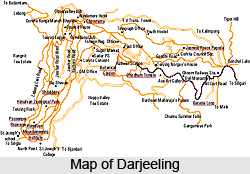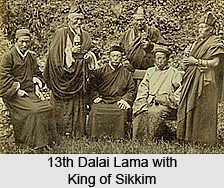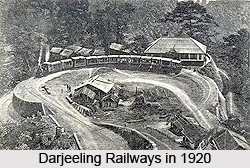 The history of Darjeeling dates to the era when, the present area of Darjeeling was a buffer state between Nepal and Bhutan. When Nepal yielded a bulk of its territory to the British Raj, they handed it over to the rajah of Sikkim on the basis of the treaty of Titlya. The Nepalese marched till the east of Sikkim in 1780 as far as Tista River. However, due to a disagreement with Nepal, the British declared war against Nepal at the end of 1813. In 1816 by a treaty signed at Seagoulie, Nepal surrendered 4000 sq. miles of territory; and due to the treaty of Titalya in 1817 the Rajah (king) of Sikkim was restored.
The history of Darjeeling dates to the era when, the present area of Darjeeling was a buffer state between Nepal and Bhutan. When Nepal yielded a bulk of its territory to the British Raj, they handed it over to the rajah of Sikkim on the basis of the treaty of Titlya. The Nepalese marched till the east of Sikkim in 1780 as far as Tista River. However, due to a disagreement with Nepal, the British declared war against Nepal at the end of 1813. In 1816 by a treaty signed at Seagoulie, Nepal surrendered 4000 sq. miles of territory; and due to the treaty of Titalya in 1817 the Rajah (king) of Sikkim was restored.
The rajah of Sikkim re-established his realm over the vast area between Teesta and Mechi. After ten years of the treaty when the dispute arose between Nepal and Bhutan over the frontier region, the British settled the dispute over area and acquired it as a lease land from Chogyal of Sikkim in 1835. In the same year, Dr Arthur Campbell, an agent of the Indian Medical Service appointed as the health inspector, who set to improve Darjeeling as a sanitorium. He became the first superintendent of the sanitorium in 1839. The road connecting Darjeeling with the plain was constructed in 1839.
Dr Campbell brought China tea seeds in 1841 from Kumaon region and started to grow tea on an experimental basis close to his residence at Beechwood, Darjeeling. This experiment was followed by similar efforts by several other British officials. The experiments were successful and soon several tea estates started operating commercially. The rapid growth of Darjeeling, which at that time continued to exist as the lease land of the British, materialized into the object of conflict between the British and the maharajah of Sikkim. Finally when the expeditionary troop of the Company advanced to Sikkim, without any bloodshed, the hostilities of Sikkim ceased. In the year 1849, the area of Darjeeling finally came under the administrative jurisdiction of the Company.

The rapid growth of Darjeeling energised the jealousy of the Maharaja of Sikkim. There were also differences between the British Government and Sikkim over the status of people of Sikkim. Because of the increased significance of Darjeeling, many citizens of Sikkim mostly of the labour class, started to settle in Darjeeling as British subjects. The migration disturbed the feudal lords in Sikkim who resorted to forcibly getting the migrants back to Sikkim. The situation deteriorated to such a limit that when Dr. Campbell and the eminent explorer Sir Joseph Dalton Hooker, were touring in Sikkim in 1849, they were even seized and imprisoned. This imprisonment continued for weeks.The Company sent an expeditionary force to Sikkim. However, there was no necessity for bloodshed, and after the Company`s troops crossed the Rangeet River into Sikkim hostilities stopped.
The British established the Darjeeling Municipality in 1850 and initiated some development works to set improvement in the young town. During this time, immigrants from the different neighbouring areas, mainly from Nepal were recruited to work in the construction sites, tea gardens and also in other agricultural projects. These workers also started to reside in the region. During this period of development, some Scottish missionaries commenced the construction of convent schools and welfare centers for the British residents here.
Since, 1980, the civic administration was under the jurisdiction of the Darjeeling Municipality. The Municipality was added to the first Schedule with Halna, Hazaribagh and Muzzaffarpur in which the commissioners are appointed as the local governments. In the second Schedule it was placed with Burdwan, Nadia and Hazaribagh where the commissioners are appointed as the local governments. The "Non- Regulated " area of Darjeeling came to be known as the Scheduled district in 1874 and the backward tract in 1919 and continued to survive as a "Backward tract" till independence. After the independence the "Backward tract" has been merged with the state of West Bengal, which constitutes the hilly regions of Darjeeling including Kurseong, Kalimpong & the parts of the Terai region. In 1950, when the People`s Republic of China annexed Tibet, a mass of Tibetan settled in the hilly tracts of Darjeeling.
Darjeeling`s privileged residents were the British ruling class of the time, who visited Darjeeling during every summer. An increasing number of well-to-do Indian residents of Kolkata, wealthy Maharajas of princely states, land-owning zamindars and barristers of Calcutta High Court also began visiting Darjeeling. Darjeeling district continued to grow as a tourist destination and was thus known as the "Queen of the Hills." The town did not see any noteworthy political activity during the freedom struggle of India owing to its isolated location and small population. However, there was a failed assassination endeavour by revolutionaries on Sir John Anderson, the Governor of Bengal in the 1930s.
After the independence of India in 1947, the district of Darjeeling was merged with the state of West Bengal. A separate district of Darjeeling was established comprising the hilly towns of Darjeeling, Kurseong, Kalimpong and some parts of the Terrain region.
 When the People`s Republic of China occupied Tibet in 1950, thousands of Tibetan refugees settled across Darjeeling district. The population rose by leaps and bounds. Growth in population has been more rapid from the 1970s onwards exceeding the growth rates at the district level.
When the People`s Republic of China occupied Tibet in 1950, thousands of Tibetan refugees settled across Darjeeling district. The population rose by leaps and bounds. Growth in population has been more rapid from the 1970s onwards exceeding the growth rates at the district level.
The rise in tourism also affected the ecological balance of the area. An assorted ethnic population gave rise to socio-economic disturbances and the demand for the creation of the separate states of Gorkhaland and Kamtapur along ethnic lines grew popular in the 1980s. Political stresses largely declined with the establishment of Darjeeling Gorkha Hill Council under the leadership of Subash Gishing. Later the name of DGHC was changed to Darjeeling Gorkha Autonomous Hill Council (DGAHC).
The history of Darjeeling has seen many ups and downs in the entire span; however, the scenic beauty and natural surroundings of the place have made it one of the internationally acclaimed tourist spot in India.



















